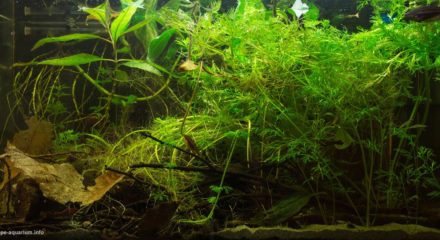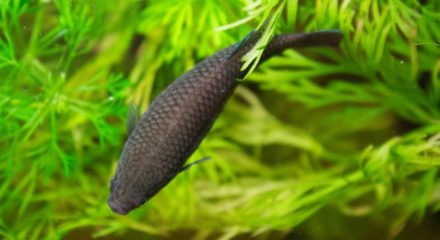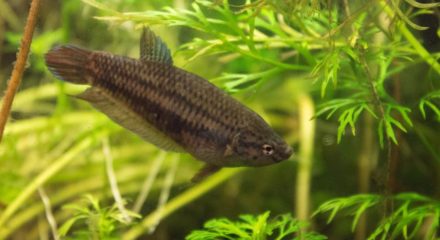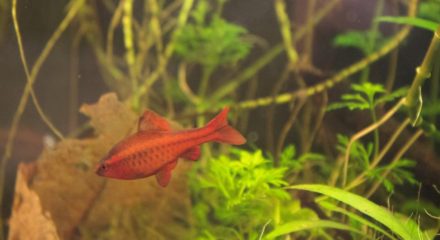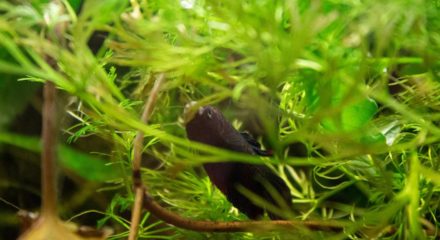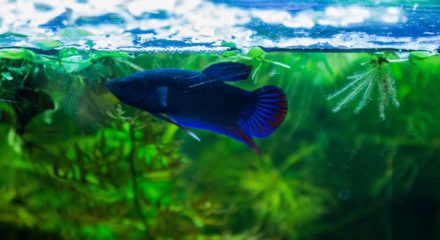Small ditch. Plain rice fields, north of Phetchaburi city. Thailand
48th place in Biotope Aquarium Design Contest 2016
![]() Italy. Andrea Vannini
Italy. Andrea Vannini
Aquarium Volume: 60 L
Fish and invertebrates: Betta splendens ancestral form Regan, Pangio semicincta, Puntius titteya, Clea helena, Planorbarius corneus
Fish and invertebrates: Betta splendens ancestral form Regan, Pangio semicincta, Puntius titteya, Clea helena, Planorbarius corneus
Plants list: Limnophila sessiliflora, Hygrophila corymbosa, Ceratopteris thalictroides, Epipremnum aureum
Biotope description: Located 160 km south of Bangkok, Phetchaburi is the capital of the homonymous Thailand Province. The climate is tropical: the rainy season starts typically in March and ceases in November (with an apex in May-October). The yearly mean air temperature is 27.9°C. However, temperatures can drop to 13-15°C during dry seasons, and raise up to 30-35°C during wet seasons. Average relative humidity (%) is 75-85% all year round. Phetchaburi Province is bordered west by Tanao Sri mountains, while the east part is the Phetchaburi River basin coastal plain. Rice (Oryza sativa) cultivation is widespread. Rice fields are frequently disturbed by human activities: lateral ditches, often bordering with remnant forest patches, represent a biodiversity-rich habitat. In this biotope, water level, temperature and transparency are strongly influenced by rainfalls and by rice cultivation. Generally, due to intensity of solar radiation, water is warm (rarely colder than 22-23°C); turbulence is almost absent. These conditions make the water poorly oxygenated, especially during hottest months. During rainfalls, underwater visibility is scarce because of soil sediments. The ditches bottom is usually dark, muddy or sandy depending on stream or coast proximity. A large amount of sediment accumulates due to limited turbulence. When there are forest patches, even branches and leaves accumulate on the bottom, enriching water in tannins and humic acids, darkening it. Water pH range: 5-7; hardness: 0-4° dKH and 4-6° dGH. The availability of light and nutrients (in the sediment) promotes the growth of many herbaceous plants, rooted or floating, which provide refuge and deposition sites for fish and other animals. Stagnant water allows the development of a rich planktonic flora and fauna, which are the basis of the biotope food web. Due to increasing urbanization, intensive farmland and pollution, these biotopes are threatened. Betta splendens is classified as vulnerable by IUCN (2011).
Biotope description: Located 160 km south of Bangkok, Phetchaburi is the capital of the homonymous Thailand Province. The climate is tropical: the rainy season starts typically in March and ceases in November (with an apex in May-October). The yearly mean air temperature is 27.9°C. However, temperatures can drop to 13-15°C during dry seasons, and raise up to 30-35°C during wet seasons. Average relative humidity (%) is 75-85% all year round. Phetchaburi Province is bordered west by Tanao Sri mountains, while the east part is the Phetchaburi River basin coastal plain. Rice (Oryza sativa) cultivation is widespread. Rice fields are frequently disturbed by human activities: lateral ditches, often bordering with remnant forest patches, represent a biodiversity-rich habitat. In this biotope, water level, temperature and transparency are strongly influenced by rainfalls and by rice cultivation. Generally, due to intensity of solar radiation, water is warm (rarely colder than 22-23°C); turbulence is almost absent. These conditions make the water poorly oxygenated, especially during hottest months. During rainfalls, underwater visibility is scarce because of soil sediments. The ditches bottom is usually dark, muddy or sandy depending on stream or coast proximity. A large amount of sediment accumulates due to limited turbulence. When there are forest patches, even branches and leaves accumulate on the bottom, enriching water in tannins and humic acids, darkening it. Water pH range: 5-7; hardness: 0-4° dKH and 4-6° dGH. The availability of light and nutrients (in the sediment) promotes the growth of many herbaceous plants, rooted or floating, which provide refuge and deposition sites for fish and other animals. Stagnant water allows the development of a rich planktonic flora and fauna, which are the basis of the biotope food web. Due to increasing urbanization, intensive farmland and pollution, these biotopes are threatened. Betta splendens is classified as vulnerable by IUCN (2011).

